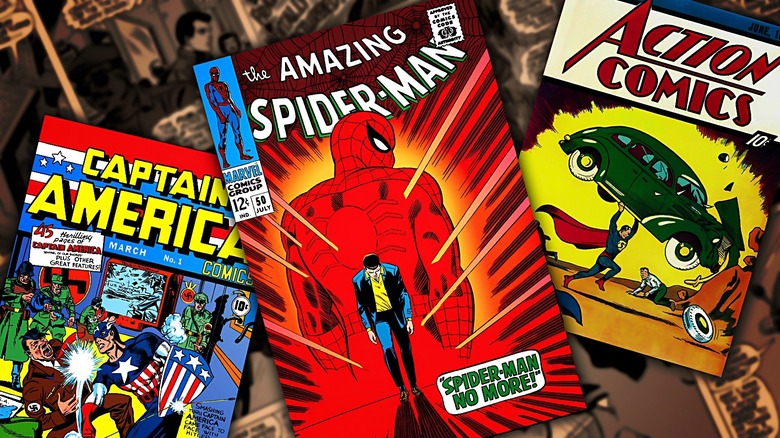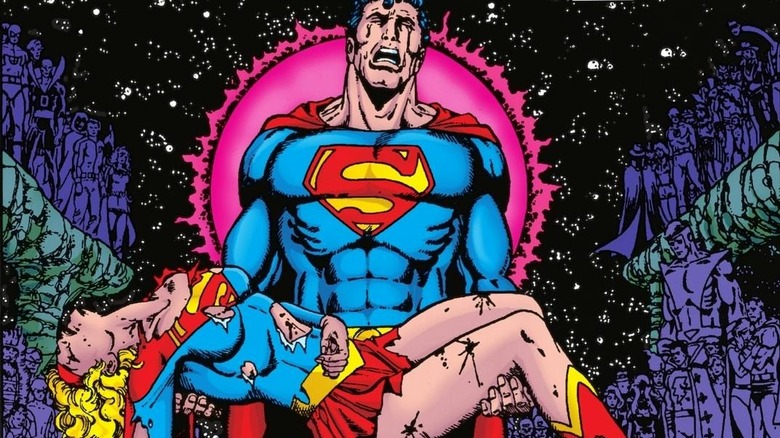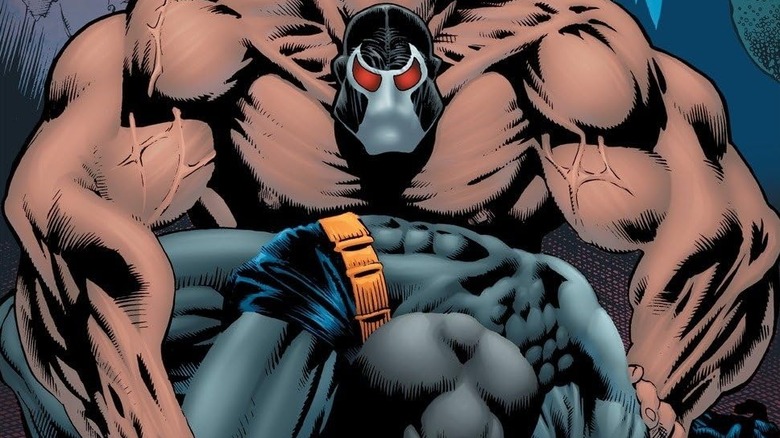10 Most Iconic Marvel And DC Comic Book Covers, Ranked
Never judge a book by its cover — unless it's a comic book, then please judge away. When you pick up a title from Marvel or DC Comics, the cover makes all the difference. It holds the ability to sell you the book in an instant, or it could be the equivalent of garlic to a vampire if it looks about as boring as two tree branches locked in a staring contest. The cover needs to convince you that what you're about to page through is both a must-read and must-buy experience.
Publishers understand the importance of covers, hence using different approaches like wraparound covers, foil variants, and embossed designs. While these add a visual impact and collector's appeal, it only works if the cover asserts itself as iconic. Now, the question is, how does one determine that? That's easy — you look at its influence on pop culture and how recognizable it is to the average person. Show someone the rare "Action Comics" #1, and they know how the image of Superman lifting a car has been referenced in other comics, shows, and movies throughout the decades. Give them a glimpse of "Action Comics" #236, though, and this is something that only diehards would be able to point out the importance of.
So, let's get to it and check out the 10 most iconic Marvel and DC comic book covers, ranked. It isn't a Batman-heavy list — promise — because the Dark Knight deserves his own showcase.
10. Captain America Comics #1
The debate for this spot proved to be a hotly contested one. Full transparency here: the two options were "Fantastic Four" #1 and "Captain America Comics" #1. In the case of "Fantastic Four," it's an iconic cover featuring Marvel's First Family battling Giganto, with the scene recreated as an Easter egg in "The Fantastic Four: First Steps." However, the /Film agreed that Captain America punching out Adolf Hitler on the cover of "Captain America Comics" #1 is too good to be ignored.
Created by Joe Simon and Jack Kirby, the cover epitomizes Cap as a character — someone who stands up for everyone against all evildoers, bigots, and Nazis. Take into account that this issue was released in December 1940, which was during World War II, leaving no doubt where Cap's allegiances stood on the matter. It's also important to note that this issue came out before the United States of America actually involved itself in the war, so this was a strong political message from the comic book creators about how they believed Hitler and his army should be treated. No arguments here, since Nazis should be slugged.
This cover was recreated in a scene from 2011's "Captain America: The First Avenger," where Steve Rogers performs the "Star Spangled Man" on stage and pretends to knock out an actor playing Hitler. That said, the message might have been more impactful had Marvel Studios committed to allowing Cap to punch out Hitler in the actual storyline.
9. The Incredible Hulk #340
Nowadays, most fans associate Wolverine and Hulk with other characters, but these two bruisers remain bound by history. In the case of Wolverine, he made his official debut in "The Incredible Hulk" #180 and featured on the cover of the next issue as he squared off against the not-so-jolly green giant. However, this isn't the most iconic cover between the pair. That honor goes to 1987's "The Incredible Hulk" #340, which was produced by Todd McFarlane and Bob Wiacek.
The simple but effective cover sees a snarling Wolverine, dressed in his brown costume, showing off his three sharp adamantium claws. In the claws' reflection, you see the Hulk, looking just as angry and readying himself to "Hulk Smash" this pint-sized furball. This image says so much with so little, promising a bone-crunching clash for the ages — and the issue doesn't disappoint on that front either, as Wolvie and Hulk tear into each other.
This image has been recreated many times over the years, as artists have put their own spin on it, including with other characters such as Deadpool and Batman. In addition, the original cover was commemorated in a short scene from "Deadpool & Wolverine" — albeit with the Merc with the Mouth thrown into the mix for extra flavor. Still, this time-hopping sequence from "Deadpool & Wolverine" provides a wonderful Easter egg for all the Marvel fans who have waited oh so patiently to see Wolvie and Hulk face off in a live-action movie.
8. Crisis on Infinite Earths #7
The year-long "Crisis on Infinite Earths" event shook up DC Comics in the mid-'80s. The purpose behind this comic book storyline was to take out the wide-spanning DC Multiverse and create a singular, unified Earth — let's call it an exercise in decluttering, shall we? Expectedly, "Crisis on Infinite Earths" had far-reaching consequences, as certain key DC heroes met their maker — much like in "Days of Our Lives," though, no one truly stays dead in comics.
The one image that's closely associated with this series is the poignant cover for "Crisis on Infinite Earths" #7 — assembled by George Pérez, Tom Ziuko, and Gaspar Saladino — which sees a weeping Superman holding the lifeless body of Supergirl. In the shadowy background are dozens of DC characters, such as Nightwing, Batman, and Wonder Woman, who all look devastated and emotional at what has transpired. The picture doesn't lie, as Supergirl dies in the issue after being killed by the Anti-Monitor. It's an event that shocks the DC Universe and Superman, but the Man of Steel also remembers that Kara Zor-El's sacrifice helped to stop Anti-Monitor's plans.
Various artists have paid homage to this image, with even Supergirl being put in Superman's place, as she mourns the loss of Draaga on the cover of "Superman: The Man of Steel" #10. The original cover would also serve as the direct influence for the poster of the 2024 animated adaptation "Justice League: Crisis on Infinite Earths, Part Three."
7. Batman #497
The Dark Knight isn't immune from being put in precarious circumstances. Many of his best covers have placed him — and Robin — in dangerous situations, where readers may think, "Holy comic book traps, Batman, I wonder if they'll escape this latest torture device." Yet, the cover for "Batman" #497, which is a part of the "Knightfall" story arc, marks one of the first times in which the Bat is broken, both figuratively and literally.
Created by Kelley Jones and Bob LeRose, this image demonstrates the power of the hulking Bane, as he cracks Batman's back over his knee in the Batcave. It's also an event that happens in the actual issue, as the Dark Knight receives a biblical beating from Bane, who ends it off by breaking the Caped Crusader's spine. Both the cover and story stunned fans, instantly setting up the new villain Bane as the man who broke the Bat and kicking off a narrative where Jean-Paul Valley assumes the mantle of Batman and beats the brakes out of criminals.
For Bane, this cover did everything to establish his reputation as one of the most dangerous rogues in comics. For Batman, it was a massive defeat, but it also showcased the otherworldly willpower of Bruce Wayne to recover from such an injury and come back as Gotham's protector. Both this moment and theme were explored in Christopher Nolan's ambitious superhero movie "The Dark Knight Rises," where Tom Hardy's Bane breaks Christian Bale's Batman's back then imprisons him.
6. Batman: The Killing Joke
When considering the worst things the Joker has ever done, look no further than 1988's "Batman: The Killing Joke." In this story, which also explores the Clown Prince of Crime's dark origins, the villain paralyzes and tortures Barbara Gordon. If that isn't enough, he takes pictures of his heinous crime, using them to traumatize her father, Jim, whose spirit he's trying to break.
"The Killing Joke" is a controversial and divisive story among critics and readers, but its cover proves to be as harrowing as the content inside. Crafted by Brian Bolland and Richard Bruning, the image features a grinning Joker, holding a camera and saying, "Smile." Everyone knows exactly which part of the book this is from, and the only person excited by this unsettling event is the psychopathic clown. Bolland's illustration of the Joker accentuates his sinister qualities, while the negative space chills the mood even further.
Arguably, "The Killing Joke" is the first time in Batman history when the Joker felt more like a truly diabolical villain than a silly prankster, and this cover goes a long way in confirming that his crimes are no laughing matter. When the story was turned into an animated film in 2016, the poster used a similar image as tribute to the original. Jared Leto also attempted to recreate his own version of the cover behind the scenes in "Suicide Squad," but yeah, let's method act and pretend like this horrendous iteration of the character never existed.
5. The Amazing Spider-Man #50
In terms of the most iconic Marvel and DC comic book covers, Spider-Man could fill this entire list with anything from the Todd McFarlane era. Whether it's the web-tacular collector's edition of "Spider-Man" #1, or Venom looming in "The Amazing Spider-Man" #316, it's banger cover after banger cover. Yet, there's a non-McFarlane cover from yesteryear that might be one of the most influential of all time, as it captures the duality of Spidey.
The cover for "The Amazing Spider-Man #50" — assembled by John Romita Sr., Stan Goldberg, and Sam Rosen — catches the eye instantly, as it shows Peter Parker walking away from a towering Spider-Man, who looks over his shoulder. The text reads, "Spider-Man no more!" In this issue, Peter begins to resent his alter ego, realizing being Spider-Man has a negative effect on his life. One evening, he walks past a trashcan, dumps his Spidey costume inside, and vows to never be Spider-Man again. This vow doesn't last for too long, but it encapsulates the crisis of identity Peter experiences, as he tries to balance his regular life with superheroics.
The visual of Peter walking away from his costume has been utilized several times throughout Spidey history, while it has also been applied to other characters. Film fans will recognize the influence that this issue has on the events of Sam Raimi's "Spider-Man 2" — one of the best comic book movies of all time — as Peter also chucks his costume in the trash.
4. Superman #75
Comic book fans hold a complicated relationship with books from the '90s. Most people see the decade as a period of hypersexualization and so much edge that even X's noisiest blue checkmarks get jealous they weren't able to monetize the controversy. That said, it wasn't all bad. DC rolled the dice on the biggest gamble ever: the publisher actually let Superman die.
Nowadays, "The Death of Superman" is remembered as one of the greatest "Superman" comics. In the '90s, people couldn't believe it would happen. The naysayers thought it would be some fake-out, or clone nonsense at play, but DC committed to it. The newsstand edition of the cover for 1993's "Superman" #75 — designed by Dan Jurgens and Brett Breeding — features a torn-off part of Superman's cape used as a makeshift flag, while mourners stand in the background. In big, bold writing on the cover, it reads, "THE DEATH OF SUPERMAN!" If you picked up a polybag edition, you would even get a memorial armband, so you, too, could pay your last respects to Kal-El.
This comic book attracted mainstream coverage, with the world in shock that DC had the gall to kill off the world's biggest superhero. Of course, the death didn't stick, as Superman returned after a few posers tried to take his place. Yet, this event — and this cover — continue to be recognized as a seismic chapter in the history of the Man of Steel and pop culture.
3. Amazing Fantasy #15
Think of a cover that embodies everything you know about Spider-Man, and it should be 1962's "Amazing Fantasy" #15 — by Jack Kirby and Steve Ditko — that comes to mind in a flash. The classic Spidey costume with underarm webbing? Check. Swinging across buildings in New York? Check. Carrying a thug like he's a bag of potatoes? Check. Speaking to himself? Double check.
While it might not be the most impressive Spidey cover ever produced, it understands the assignment in what it's meant to do, which is to introduce the superhero to the world in all his glory. The layout also remains one of the most duplicated in comic book history — not just in Spidey comics but other titles as well. A variant cover of 2015's "Star Wars" #1 sees Princess Leia in the Spidey role as she carries Luke Skywalker. In addition, an alternate cover for 2011's "Daredevil" #7 shows off the Man Without Fear lugging around his nemesis Bullseye. So, yeah, artists love to pay tribute to "Amazing Fantasy" #15 whenever the opportunity presents itself.
If you own a copy of the book — which is also one of the best Spider-Man comics you need to read — you may want to get it evaluated. In September 2021, a copy of "Amazing Fantasy" #15 sold for $3.6 million at an auction, according to The New York Times. Now, that will certainly help you buy a lot of cheese sticks!
2. Action Comics #1
Was there any other choice for an image that nails Superman in one go here? Not only does 1938's "Action Comics" #1 serve as the world's introduction to the Man of Steel, but the cover also successfully represents what he's all about. The cover — created by Joe Shuster and Jack Adler — demonstrates the awe-inspiring power of Superman as he lifts a green car above his head and prevents an accident from claiming lives. That said, it's imperative that people check their vehicle's brakes at regular intervals rather than rely on Superman's intervention to avert disaster.
Much like "Amazing Fantasy" #15, it's a cover that's been replicated many times in Superman comics and across other titles as well. However, it's also been brought to life in live action on two memorable occasions. While 2006's "Superman Returns" largely disappoints, Brandon Routh's Kal-El stops a car crash in a scene that pays homage to the iconic cover. Then, in the first episode of "Superman & Lois" season 1, Tyler Hoechlin's Man of Steel stops a green car from crashing into a kid, dressed in the same threads as the original character (his mom made it for him, according to Supes himself).
So, how valuable is this cover? Well, on its own (without the rest of the book), it sold for $408,000 in June 2025, according to ICv2.
1. X-Men #1
Determining which is the most iconic Marvel and DC comic book cover didn't prove to be too difficult, because how can anyone look past 1991's "X-Men" #1? Professor Xavier's mutants had been around for decades before, but this book — especially its impressive gatefold cover by Jim Lee and Scott Williams — reinvigorated the heroes for a new generation, and subsequent ones thereafter. Imagine walking into a comic book store and seeing this on the shelf in the early '90s. It's impossible to ignore, or not be intrigued by it.
Lee perfects the personality of each character on this action-packed cover that establishes the X-Men as one of the coolest superhero teams around. The artist's character and costume designs also turned out to be the main inspiration for the wildly popular "X-Men: The Animated Series" — one of the best Saturday morning cartoons of all time — and various other adaptations in the future.
Unquestionably, Marvel Comics marketed the title perfectly, releasing the various covers and the eventual gatefold that showcased the big action sequence, but it paid off in the end. "X-Men" #1 remains the best-selling single-issue comic book of all time, selling over eight million copies, as per the Guinness World Records. Yeah, people judged this book by its cover, and most fans agreed that it was fantastic.










